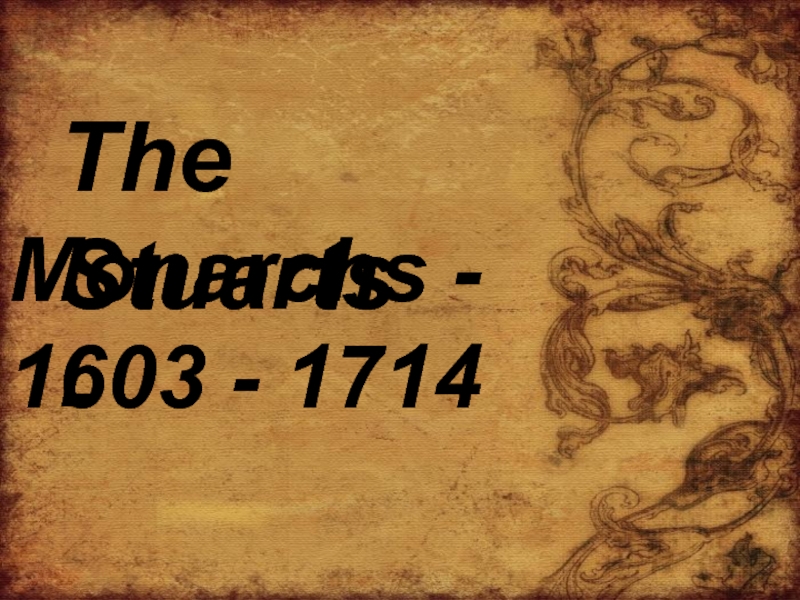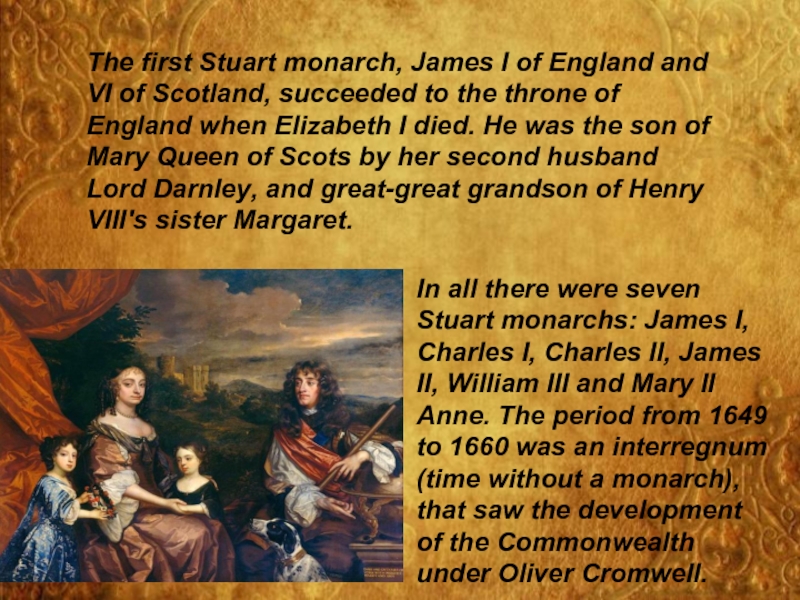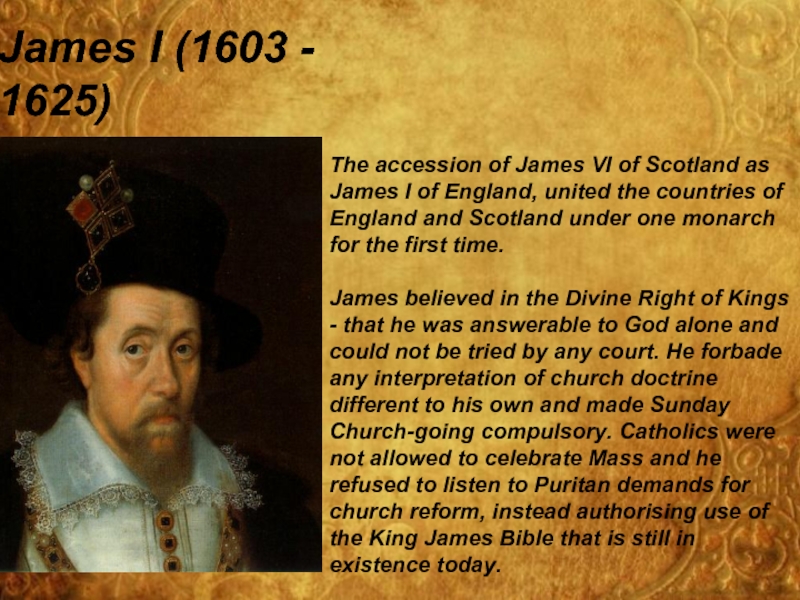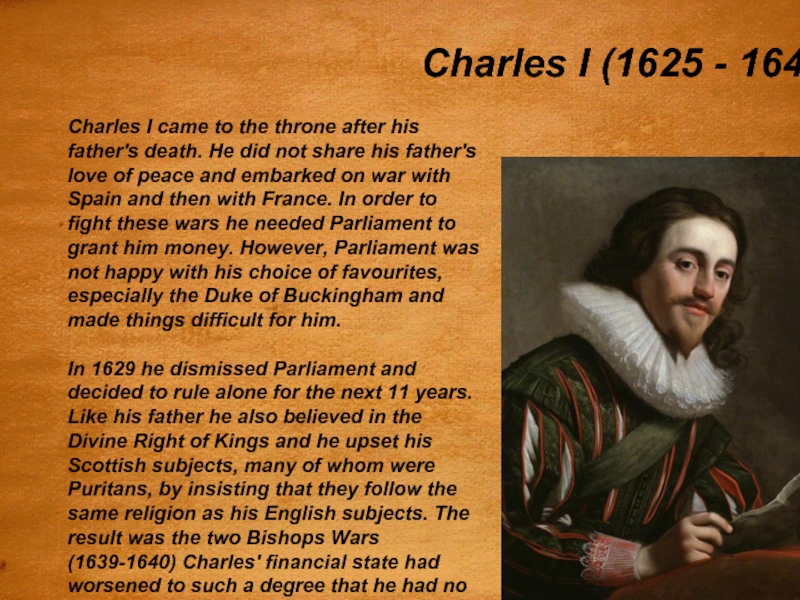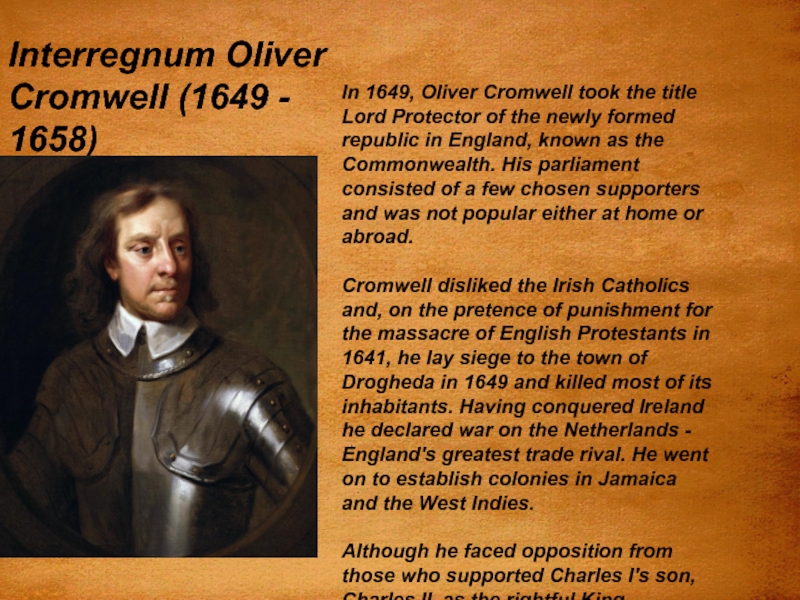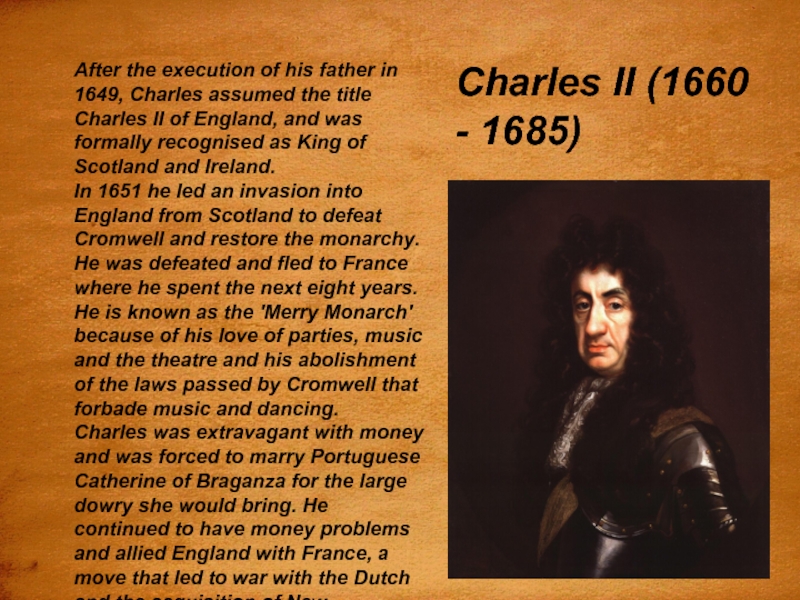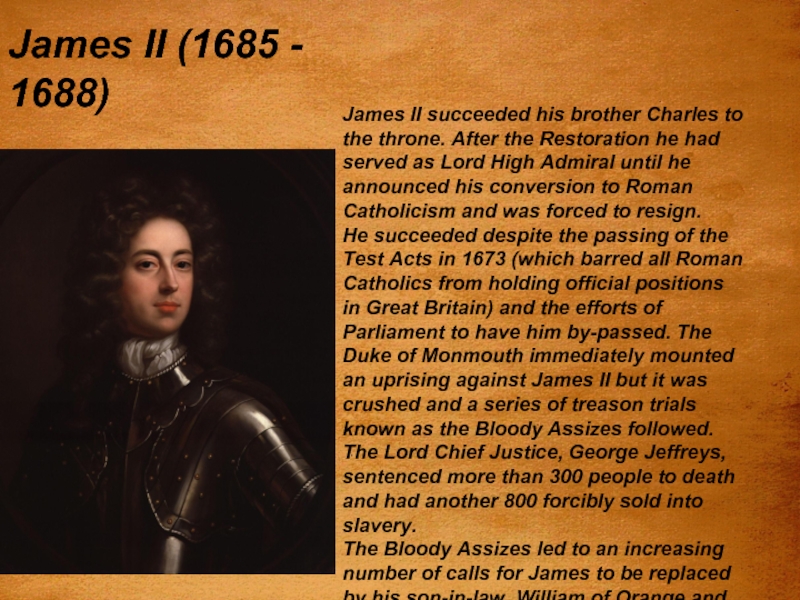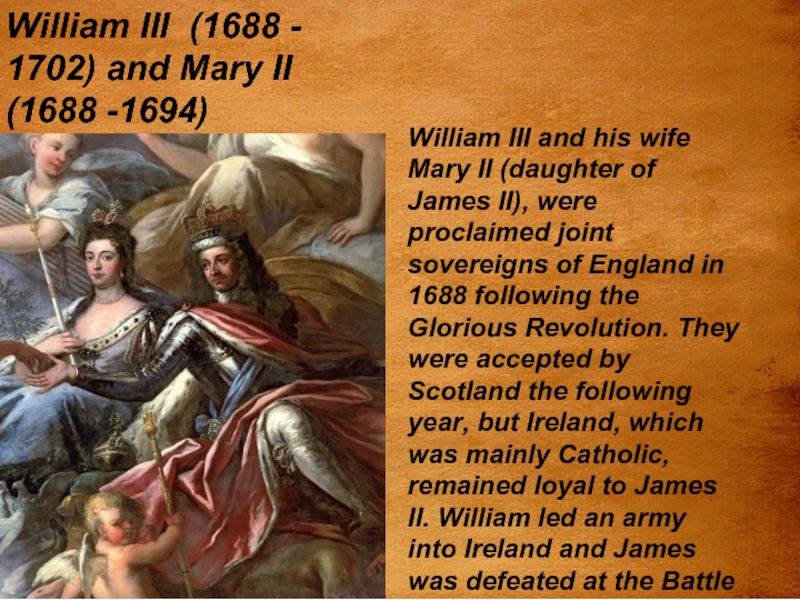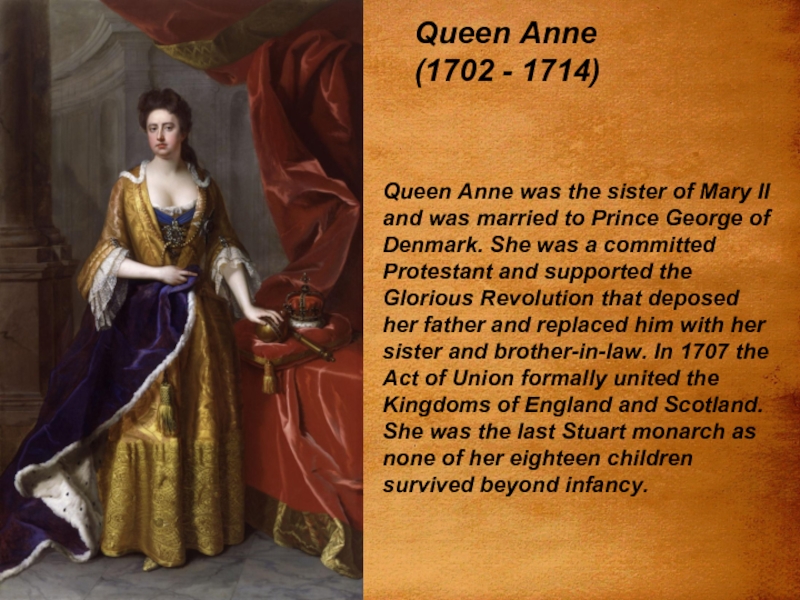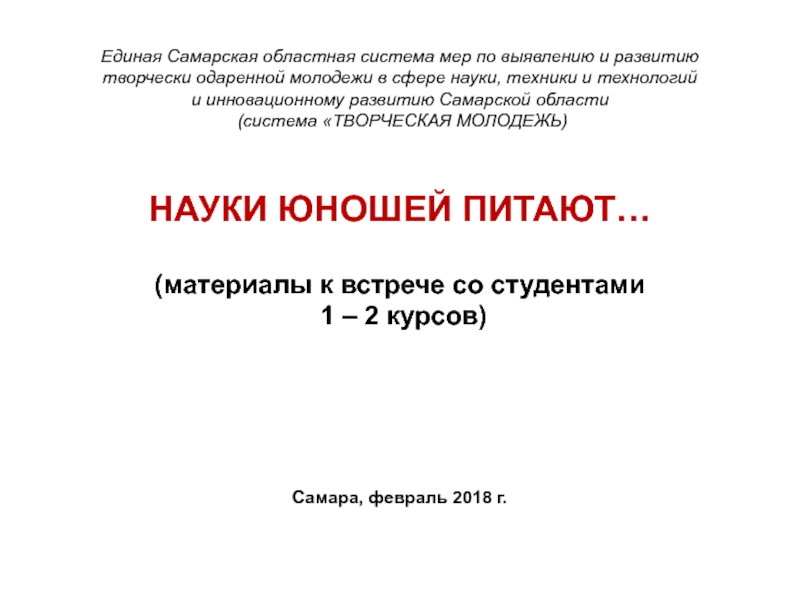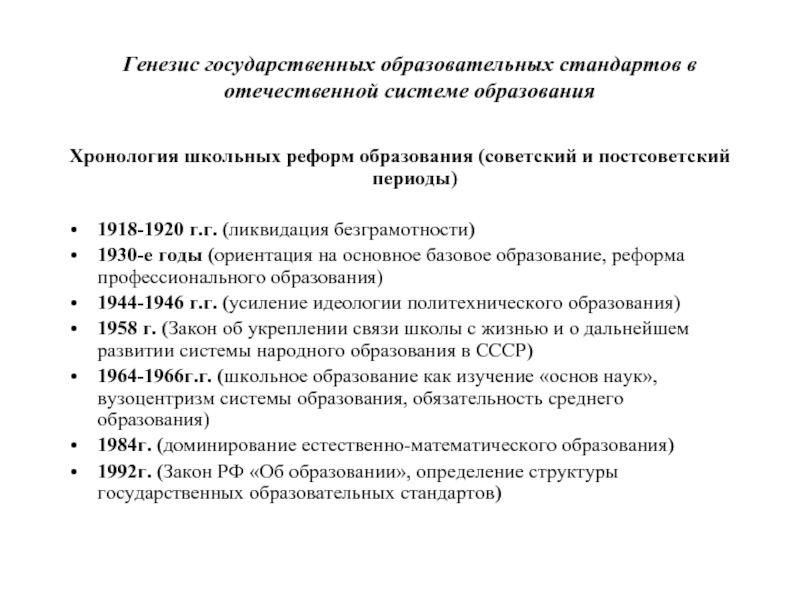- Главная
- Разное
- Дизайн
- Бизнес и предпринимательство
- Аналитика
- Образование
- Развлечения
- Красота и здоровье
- Финансы
- Государство
- Путешествия
- Спорт
- Недвижимость
- Армия
- Графика
- Культурология
- Еда и кулинария
- Лингвистика
- Английский язык
- Астрономия
- Алгебра
- Биология
- География
- Детские презентации
- Информатика
- История
- Литература
- Маркетинг
- Математика
- Медицина
- Менеджмент
- Музыка
- МХК
- Немецкий язык
- ОБЖ
- Обществознание
- Окружающий мир
- Педагогика
- Русский язык
- Технология
- Физика
- Философия
- Химия
- Шаблоны, картинки для презентаций
- Экология
- Экономика
- Юриспруденция
The Stuarts - monarchs презентация
Содержание
- 1. The Stuarts - monarchs
- 2. The first Stuart monarch, James I of
- 3. James I (1603 - 1625) The accession
- 4. Charles I (1625 - 1649) Charles I
- 5. Interregnum Oliver Cromwell (1649 - 1658) In
- 6. Charles II (1660 - 1685) After the
- 7. James II (1685 - 1688) James II
- 8. William III (1688 - 1702) and Mary
- 9. Queen Anne (1702 - 1714) Queen Anne
- 10. Thank you for your attention Prepared by Zhukunova Julia 102 group
Слайд 2The first Stuart monarch, James I of England and VI of
In all there were seven Stuart monarchs: James I, Charles I, Charles II, James II, William III and Mary II Anne. The period from 1649 to 1660 was an interregnum (time without a monarch), that saw the development of the Commonwealth under Oliver Cromwell.
Слайд 3James I (1603 - 1625)
The accession of James VI of Scotland
James believed in the Divine Right of Kings - that he was answerable to God alone and could not be tried by any court. He forbade any interpretation of church doctrine different to his own and made Sunday Church-going compulsory. Catholics were not allowed to celebrate Mass and he refused to listen to Puritan demands for church reform, instead authorising use of the King James Bible that is still in existence today.
Слайд 4Charles I (1625 - 1649)
Charles I came to the throne after
In 1629 he dismissed Parliament and decided to rule alone for the next 11 years. Like his father he also believed in the Divine Right of Kings and he upset his Scottish subjects, many of whom were Puritans, by insisting that they follow the same religion as his English subjects. The result was the two Bishops Wars (1639-1640) Charles' financial state had worsened to such a degree that he had no choice but to recall a Parliament whose condemnation of his style of rule would lead the country to Civil War and Charles I to his execution in 1649.
Слайд 5Interregnum Oliver Cromwell (1649 - 1658)
In 1649, Oliver Cromwell took the
Cromwell disliked the Irish Catholics and, on the pretence of punishment for the massacre of English Protestants in 1641, he lay siege to the town of Drogheda in 1649 and killed most of its inhabitants. Having conquered Ireland he declared war on the Netherlands - England's greatest trade rival. He went on to establish colonies in Jamaica and the West Indies.
Although he faced opposition from those who supported Charles I's son, Charles II, as the rightful King, (especially the Scots), Oliver Cromwell succeeded in establishing a sound reputation for the Commonwealth by the time of his death in 1658. He was succeeded by his son Richard, who had no wish to rule.
Слайд 6Charles II (1660 - 1685)
After the execution of his father in
In 1651 he led an invasion into England from Scotland to defeat Cromwell and restore the monarchy. He was defeated and fled to France where he spent the next eight years.
He is known as the 'Merry Monarch' because of his love of parties, music and the theatre and his abolishment of the laws passed by Cromwell that forbade music and dancing.
Charles was extravagant with money and was forced to marry Portuguese Catherine of Braganza for the large dowry she would bring. He continued to have money problems and allied England with France, a move that led to war with the Dutch and the acquisition of New Amsterdam (now New York) for England. Charles II died in 1685.
Cromwell's opponents were easily able to overthrow him and after a period of anarchy the monarchy was restored with the accession of Charles II.
Слайд 7James II (1685 - 1688)
James II succeeded his brother Charles to
He succeeded despite the passing of the Test Acts in 1673 (which barred all Roman Catholics from holding official positions in Great Britain) and the efforts of Parliament to have him by-passed. The Duke of Monmouth immediately mounted an uprising against James II but it was crushed and a series of treason trials known as the Bloody Assizes followed. The Lord Chief Justice, George Jeffreys, sentenced more than 300 people to death and had another 800 forcibly sold into slavery.
The Bloody Assizes led to an increasing number of calls for James to be replaced by his son-in-law, William of Orange and in 1688 the Dutchman was invited to take the English throne. William's subsequent invasion of England and accession to the throne is known as The Glorious Revolution. James fled to France where he lived until his death in 1701.
